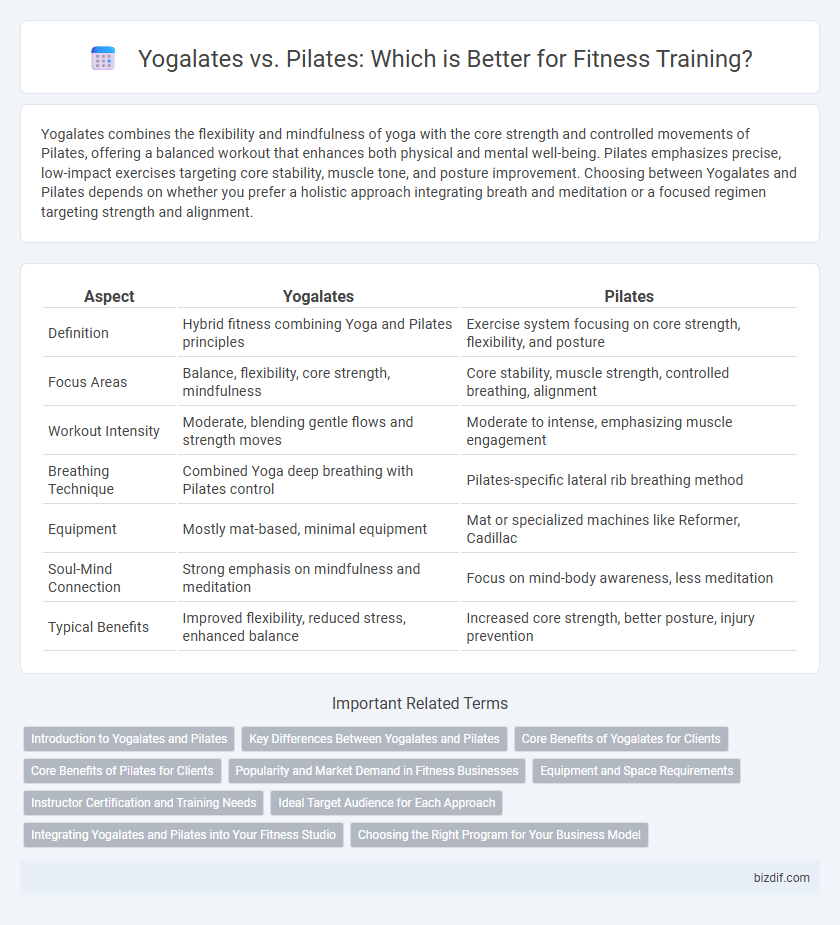Yogalates combines the flexibility and mindfulness of yoga with the core strength and controlled movements of Pilates, offering a balanced workout that enhances both physical and mental well-being. Pilates emphasizes precise, low-impact exercises targeting core stability, muscle tone, and posture improvement. Choosing between Yogalates and Pilates depends on whether you prefer a holistic approach integrating breath and meditation or a focused regimen targeting strength and alignment.
Table of Comparison
| Aspect | Yogalates | Pilates |
|---|---|---|
| Definition | Hybrid fitness combining Yoga and Pilates principles | Exercise system focusing on core strength, flexibility, and posture |
| Focus Areas | Balance, flexibility, core strength, mindfulness | Core stability, muscle strength, controlled breathing, alignment |
| Workout Intensity | Moderate, blending gentle flows and strength moves | Moderate to intense, emphasizing muscle engagement |
| Breathing Technique | Combined Yoga deep breathing with Pilates control | Pilates-specific lateral rib breathing method |
| Equipment | Mostly mat-based, minimal equipment | Mat or specialized machines like Reformer, Cadillac |
| Soul-Mind Connection | Strong emphasis on mindfulness and meditation | Focus on mind-body awareness, less meditation |
| Typical Benefits | Improved flexibility, reduced stress, enhanced balance | Increased core strength, better posture, injury prevention |
Introduction to Yogalates and Pilates
Yogalates combines the flexibility and mindfulness of yoga with the core-strengthening and controlled movements of Pilates, offering a balanced workout for improved posture and muscle tone. Pilates focuses on building core strength, stability, and precise body alignment through low-impact exercises often performed on mats or specialized equipment. Both practices enhance body awareness, but Yogalates integrates breath control and meditation techniques, creating a holistic approach to physical and mental fitness.
Key Differences Between Yogalates and Pilates
Yogalates combines the flexibility and mindfulness of yoga with the core strengthening and muscle toning techniques of Pilates, emphasizing breath control and holistic body awareness. Pilates primarily targets core stability, muscle strength, and posture through controlled, precise movements often performed on specialized equipment. While Yogalates integrates flowing sequences enhancing relaxation and flexibility, Pilates focuses more on alignment, muscle endurance, and rehabilitation benefits.
Core Benefits of Yogalates for Clients
Yogalates uniquely combines the strength-building and flexibility benefits of Pilates with the mindfulness and balance of yoga, targeting deep core muscles for enhanced stability and posture. Clients experience improved abdominal strength, reduced back pain, and increased overall body awareness through controlled, deliberate movements and breathing techniques. This holistic approach supports injury prevention and functional fitness, making Yogalates ideal for those seeking both physical and mental wellness.
Core Benefits of Pilates for Clients
Pilates emphasizes controlled movements that strengthen the deep core muscles, improving overall stability and posture. This method enhances spinal alignment and flexibility, reducing the risk of back pain and injury. Clients experience increased muscle tone and endurance, supporting everyday functional movements and athletic performance.
Popularity and Market Demand in Fitness Businesses
Pilates maintains higher popularity and market demand in fitness businesses worldwide due to its established reputation and broad appeal for rehabilitation and core strengthening. Yogalates, combining yoga and Pilates elements, is gaining traction but remains a niche offering compared to traditional Pilates studios. Fitness centers increasingly incorporate Pilates classes to attract diverse clientele seeking low-impact, strength-focused workouts.
Equipment and Space Requirements
Yogalates combines elements of yoga and Pilates, typically requiring minimal equipment such as a mat and occasionally light weights or resistance bands, making it suitable for small spaces or home workouts. Pilates often involves specialized equipment like the Reformer, Cadillac, and stability chairs, which demand more space and investment, typically found in dedicated studios. Choosing between Yogalates and Pilates depends on available space and equipment budget, with Yogalates offering greater flexibility for limited environments.
Instructor Certification and Training Needs
Yogalates combines elements of yoga and Pilates, requiring instructors to obtain certification in both disciplines to effectively teach the hybrid practice, often through specialized training programs. Pilates instructors generally pursue comprehensive certification that emphasizes anatomy, mat and equipment exercises, and biomechanics, ensuring a deep understanding of body mechanics. Yogalates instructors must meet training needs that cover yoga postures, Pilates techniques, and breath control to deliver a safe and well-rounded workout experience.
Ideal Target Audience for Each Approach
Yogalates combines the flexibility benefits of yoga with the core strengthening focus of Pilates, making it ideal for individuals seeking a balanced workout that enhances mindfulness, flexibility, and muscle tone. Pilates emphasizes controlled movements and core stability, catering to those recovering from injury or aiming to improve posture and overall strength through precision. Fitness enthusiasts looking for a low-impact, full-body workout with stress reduction often gravitate towards Yogalates, while those prioritizing rehabilitation, muscle endurance, and alignment typically prefer Pilates.
Integrating Yogalates and Pilates into Your Fitness Studio
Integrating Yogalates and Pilates into your fitness studio enhances client engagement by combining the flexibility and mindfulness of Yoga with the core strength and controlled movements of Pilates. Offering hybrid classes boosts membership retention and attracts a diverse clientele seeking comprehensive body-mind workouts. Incorporate certified instructors and use targeted marketing to highlight the unique benefits of this fusion for improved posture, balance, and overall fitness.
Choosing the Right Program for Your Business Model
Yogalates, combining yoga's flexibility with Pilates' core strengthening, appeals to clients seeking a holistic mind-body workout, ideal for studios emphasizing wellness and stress reduction. Pilates programs focus more on controlled movements and muscle conditioning, attracting clients aiming for rehabilitation and physical fitness, fitting businesses geared toward athletic training or physical therapy. Selecting the right program depends on your target market's preferences, your instructors' expertise, and the overall brand positioning of your fitness business.
Yogalates vs Pilates Infographic

 bizdif.com
bizdif.com